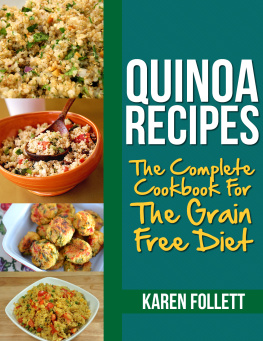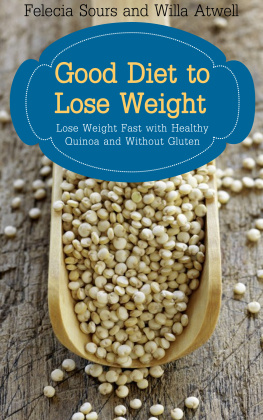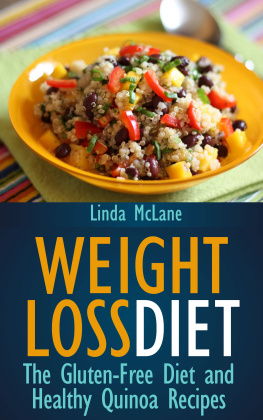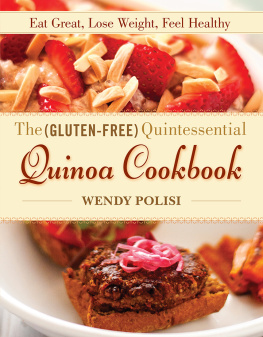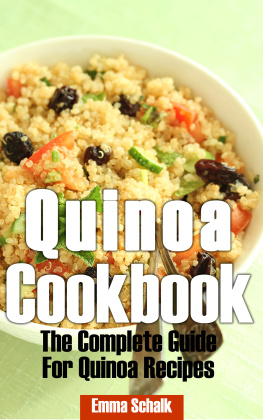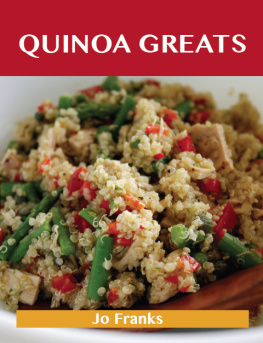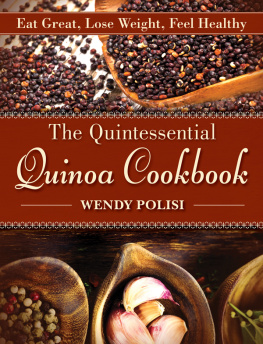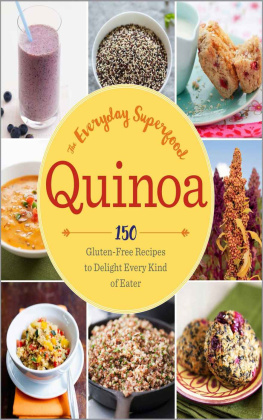Table of Contents
Quinoa Recipes
The Complete Cookbook For The Grain Free Diet
By: Karen Follett
Copyright 2013 Karen Follett
All rights reserved.
What Is Quinoa?
About the Grain
Its scientific name is Chenopodium quinoa, and it has recently gained popularity as a grain of high nutritional value.
Quinoa is an annual plant which is a type of weed related to the goosefoot family. It is also closely related to the family of plants that includes spinach, table beet, and sugar beets and is susceptible to the same issues as these crops while growing. Unlike grassy grain plants, the quinoa has broadleaf and is not a legume but has a similar structure to buckwheat.
It is a remarkably efficient plant to harvest and just one pound of seeds is enough to harvest a whole acre of the crop. This was able to sustain an Andean family of ten for a whole year.

Quinoa History
The origins of Quinoa date back over 3,000 to the ancient Incan civilizations of South America. The indigenous tribes in the Andes area of Peru, Colombia, Chile, and Bolivia used it as a staple grain in their diet.
It is one of the few grains that is able to survive the high altitudes of the region and the harshness of the Andes climate. This area is subject to intense sun, drought, and occasional frost as well. All of these conditions the hearty grain was able to withstand for thousands of years. Its strength was admired by the Ancient Incans who called it mother grain and treated its harvest with religious reverence.
During the 16th century Spanish invaders came to the Andes region and forbid the growing of quinoa which was seen as Indian food. They favored the assimilation of the savage natives into their culture and so corn and potatoes took quinoas place. However, the grain endured and grew in the wild so that we could enjoy it today.
The modern popularity of quinoa can be traced back to the 1970s when Oscar Ichazo, a Bolivian spiritual teacher, encouraged students to eat the grain as an aid to meditation. This began its rise in popularity in the Western World where even the United Nations has declared it a super food.
Health Benefits
Studies in recent history have shown that the phytonutrients in quinoa has anti inflammatory properties. The combination of properties has been shown to reduce conditions such as obesity in lab animals when fed on a regular basis as a preventative measure. These anti inflammatory phytonutrients include; Arabians, hydroxybenzoic acids, hydroxycinnamic, flavanoids, saponins, omega-3 fatty acid, and alpha-linolenic acid (ALA) it is higher in healthy fats than other cereal grains and is shown to help reduce cholesterol.
Nutritionally, a cup of cooked quinoa contains 160 calories, 2.5 grams of fat and 6 grams of protein.
Quinoa also contains antioxidant phytonutrients in a high enough amount to be compared to those in cranberry and lingonberry. Unlike other grains, quinoa is a great source of protein, comparable even to that of milk. It also contains twice the amount of calcium found in whole wheat. Other vitamins that quinoa contains are; iron, phosphorous, and B vitamins. Also found in high amounts in quinoa members of the vitamin E family, especially gamma-tocopherol. Another benefit of quinoa is its tolerance for those with other grain allergies. For those with gluten intolerances, quinoa is commonly suggested as a replacement for the traditional wheat. It is easily digestible which makes it highly desirable for the sensitive digestive tracts of those with allergies and also children.
Besides the nutritional value of quinoa, Incans used it as medicine as well. Ground quinoa was cooked down and used to treat a variety of ailments such as; appendicitis, tuberculosis, and motion sickness. It was also used as a diuretic and to induce vomiting. Its strength was believed to help build bones and strengthen mothers before and after birth, long before its high calcium content was discovered by scientists.
The super food benefits of quinoa are easy to incorporate into a healthy diet. The grain can be purchased in bulk and stored in bins. When shopping for quinoa in bulk ensure the source containers are free of moisture. Quinoa is a grain that expands greatly when prepared and so this should be taken into consideration when deciding on how much to purchase at a time. It can be stored in a dry container for 6 months in the refrigerator without losing nutritional value. The most common variety of quinoa is an off-white color however you may also see the black or red colored types. Stores may also combine the three in one bulk bin allowing you to enjoy the variety of all.
Quinoas popularity among the gluten free enthusiasts has led to it being available in flour form as well. It is highly digestible and can be used as a complete substitute for flour in recipes. However, usually it is combined with other gluten free flour such as tapioca or rice.
The internet is full of recipes using quinoa. The general way to cook the grain is to boil it with water in a ration of 2:1. Once it reaches a boil the heat should be reduced and allowed to simmer while covered. Cooking it with this boiling method takes only 15 minutes. To enhance the nutty flavor of quinoa the grain can be dry roasted before cooking. For dry roasting it is heated in a skillet over medium-high heat for a couple of minutes before boiling.
What Are The Health Benefits Found In Quinoa
There are several health benefits to Quinoa, pronounced keen-wah or Ken-noh-a, when this grain like seed is incorporated into a regular meal plan or recipe. The possible health benefits range from relief from stomach and digestive system discomfort to a reduction in blood pressure.
First and foremost Quinoa is perfect for those on a gluten free diet. Quinoa is a not a grain. It is a seed from plants that are in the same family as beets, spinach and even tumbleweeds. Because it is a seed and not a grain it is naturally gluten free. Those on a gluten free diet can incorporate Quinoa in their diets as a type of faux grain. This is possible because of many of the grain like characteristics that quinoa has. Quinoa can be used as an ingredient similar to flour in recipes order to make breads, pastries, cookies and more.

The ability to substitute Quinoa as a grain in specialized recipes allow people with a gluten intolerance the ability to avoid stomach and digestive problems that are often associated with their condition. Gluten free diets are also often associated with those who are lactose intolerant or following a lactose free diet.
Quinoa is a wonderful addition to menu planning for people following a vegetarian, vegan or any other type of low or non-meat diet. This is because Quinoa is a source for natural protein that is plant based instead of animal based. Grains are not considered to be a proper protein source. This is because grains have low amino acids levels pertaining to lysine and isoleucine. Since Quinoa is a seed and not a grain it has higher levels of lysine and isoleucine which is what is needed for a protein source to be considered a complete protein source.
A single 3.5 ounce serving of prepared Quinoa contains upwards of 14 grams of protein. This may help solve any issues that some dieters may have of not getting enough protein when following any style of vegetarian diet. The ability to take in protein can help reduce the possible need for processed over the counter protein supplements. The quality of such protein supplements can vary greatly between manufactures.

